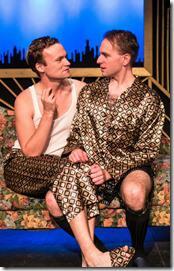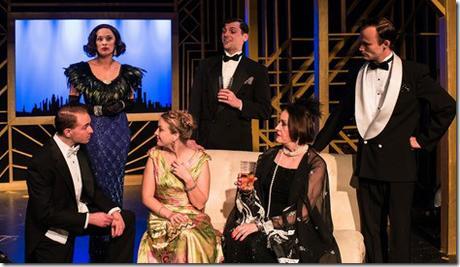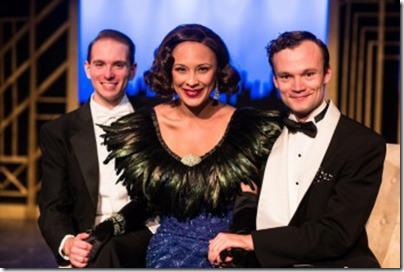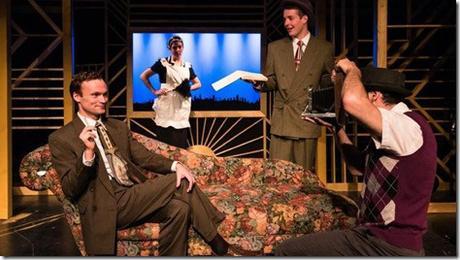
Design for Living
Written by Noel Coward
at Rivendell Theatre, 5779 N. Ridge (map)
thru Nov 22 | tix: $22-$27 | more info
Check for half-price tickets
Three is never a crowd in this vibrant update

Pride Films and Plays presents
Design for Living
Review by Clint May
Few things are as enticing—or as great a bit of inadvertent PR—than the label of “banned.” When Noel Coward‘s semi-autobiographical Design for Living was sent to Broadway after being banished from London, the crowds at the final week required a police presence to be contained. When it finally made it to Noel’s native land in 1939, it was already labeled “faded” by social critics despite the monocle-dropping nature of the source material that scandalized a half dozen years prior. That kind of talk makes one acutely aware of the conservative backlash following WWII that has actually kept Design a rather prescient look at modern love.

As starving artists in the bohemian depths of Paris, Leo (Kevin Webb) and Otto (Matthew Gall) vied for the affections of a manic pixie dream girl named Gilda (Carmen Molina). Elusive muse that she fancies herself, she took Otto to her bosom because she felt him “weaker” (and thus more in need) though neither she nor Leo could give up the ghost of affection that lay between them as well. Years later, success has transformed the two men but they remain stuck in a love triangle with Gilda at the apex. When Leo arrives to find Otto out of town, it sets in motion a chain of events that force all involved to acknowledge that they simply can’t be denied what they want for the sake of social propriety. They must, in effect, come out of a closet of their own making.
Design crackles with Coward’s trademark whiplash wit and one liners. Beneath the circumlocution, a deep well of compassion for humanity’s fallibility is evident (though it would take decades for critics to see it). Otto even acknowledges that the problem is “too many words, masses and masses of words, spewed about” that obfuscate the truth beneath. Many of Coward’s criticisms of a world that forced him to cover up his own homosexuality are barely disguised, but even stand-in-for-social-blandness Ernest (Edward Fraim) isn’t entirely unsympathetic. If anything, Coward seems to view him as lovably absurd and also trapped in another kind of closet entirely. Design even takes time to target the concepts of artistic sell out and compromise with commentary that remains evergreen.

[Mild spoiler alert ahead] Director Derek Bertelsen makes Otto and Leo’s originally implicit bisexuality physically overt, which probably would have thrilled Coward and is certainly a welcome catharsis to modern audiences who still clamor for a “will they or won’t they” moment in any relationship. Though there are some rough tonal edges in the first act, the second nails the fallout and eventual realizations with aplomb.
Casting for the triumvirate at the center is the true delight. Molina looks and acts every bit the pouty ingenue with the arch eyebrows to match her wit and the lips of someone always ready for the next pithy criticism. Gall is boyishly charming and bounces off of and into his castmates as a puppy might when confronted with too much stimulus. As Coward’s reflection, Webb is a flamboyant peacock (mirrored in John Nasca’s beautiful costume work) that perhaps plays as a little too far right on the Kinsey Scale to be believably bisexual but is nonetheless an enormously magnetic character. Together they transform some classically unlikeable egoists into triumphant warriors for that confounding and uncompromising promise of a happier affection just over the horizon.
Ultimately Design for Living is a valentine to Coward’s close friends Alfred Lunt and Lynn Fontanne and a bittersweet bit of aching nostalgia for a less-complicated time before the corruptions of fame. That it still lands with force as a defiant flag planted on the mountain of personal freedom is a testimony to The Master’s uncanny knack for finding the universal in the personal. There’s a moral as humane as it is self-centered for a yet more self-centered age—act as you must, and let others figure out how to live with it.
Rating: ★★★½
Design for Living continues through November 22nd at Rivendell Theatre, 5779 N. Ridge (map), with performances Thursdays-Saturdays at 7:30pm, Sundays 3:30pm. Tickets are $22-$27, and are available by phone (800-737-0984) or online through Vendini.com (check for half-price tickets at Goldstar.com). More information at PrideFilmsandPlays.com. (Running time: 2 hours 30 minutes, includes an intermission)

Photos by Paul Goyette
artists
cast
Carmen Molina (Gilda), Kevin Webb (Leo), Matthew Gall (Otto), Edward Fraim (Ernest), Nora Lise Ulrey (Helen Carver), Mike Newquist (Henry Carver), Joan McGrath (Grace Torrence), Amber Snyder (Miss Hodge), David Lipschutz (Matthew, photographer), Connor Baty (Mr. Birbeck)
behind the scenes
Derek Bertelsen (director), John Nasca (costume design), Kendra Kingsbury (dialect coach), Melanie Kulas (stage manager), Alexandra Bennett (dramaturg, assistant director), Brian Estep (hair and make-up design), G. Max Maxin IV (scenic and lighting design), Kallie Rolison (sound design), Paul Goyette (photos)
15-1045

